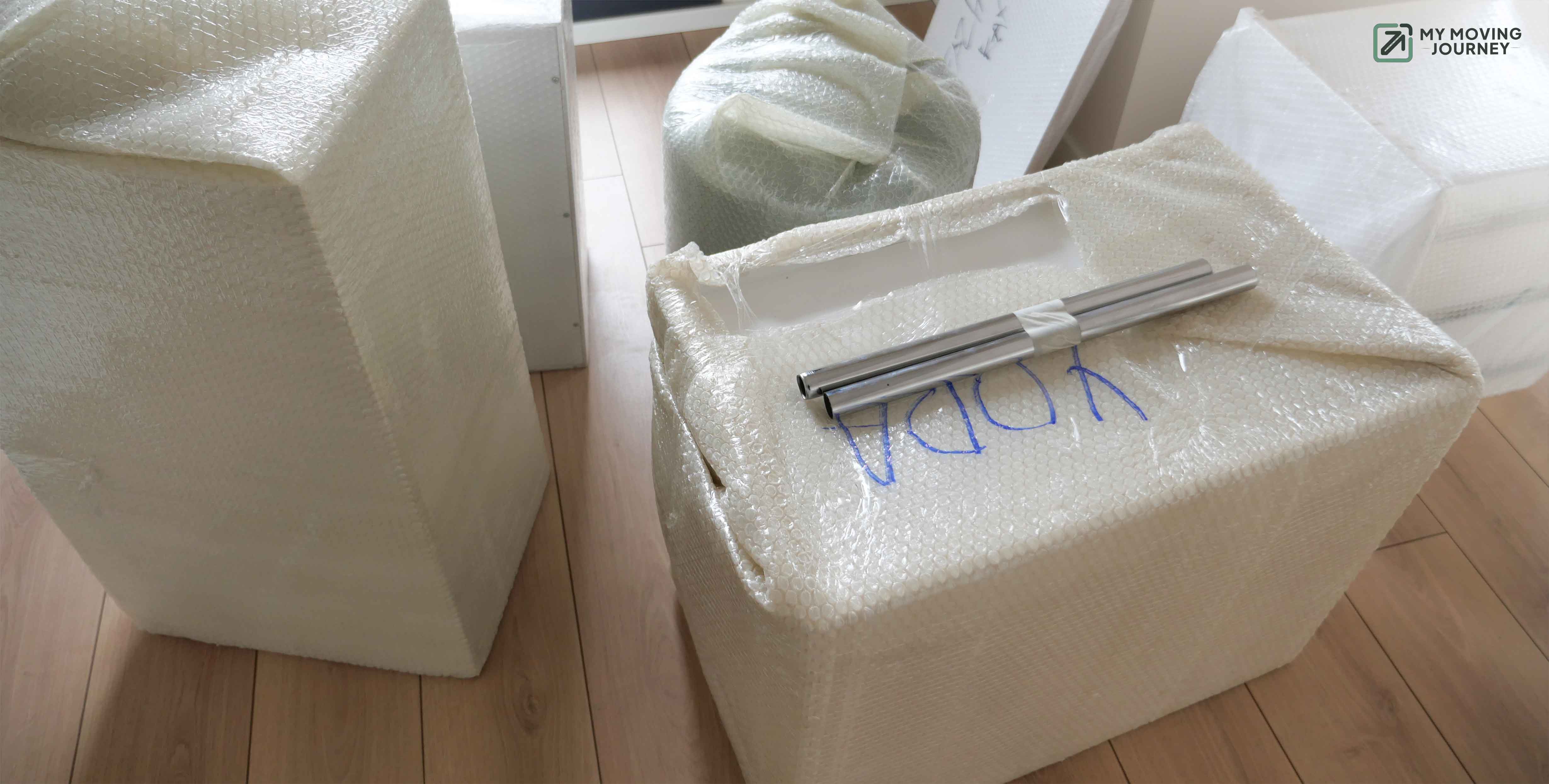Packing clothes for a move might not seem like a big deal, but it can quickly turn into a real headache. Did you know that packing clothes takes up about 15-20% of the total time and effort needed for a move? And more than 50% people say it stresses them out.
It’s not just about stuffing clothes into boxes—you’ve got to think about protecting them from damage, making the most of limited space, and keeping everything organized to ease up the unpacking process.
With an average American moving 11.7 times in their lifetime, figuring out how to pack your clothes for moving can make a huge difference in making the whole process smoother and less stressful.
6 Key Preparations to Tackle Before You Pack Up
Simply folding and cramming items into suitcases or boxes may lead to chaos on a moving day. There are several key preparations to tackle before you start packing your clothes.
- Take Stock of Your Wardrobe: First things first, take a good look at what you’ve got. Lay everything out—hang your clothes up and spread out the folded ones on your bed. This will give you a clear view of what you’re working with.
- Sort Your Clothes: Now, break down your wardrobe into three piles: keep, donate, and sell. Think about when you last wore each item, if it’s still in style, if it fits, and its overall condition. If it’s not meeting your needs, it might be time to let it go.
- Donate Wisely: For gently used items, consider donating them to a local charity. Most places provide a tax-deductible receipt, and some even offer pickup services if you have a lot to give away.
- Sell What’s Trendy: If you have clothes that are still in great shape and on-trend, think about selling them. Online marketplaces, yard sales, and stores are all good options for making a bit of cash.
- Preserve Sentimental Items: For those precious items you are not ready to part with, like wedding dresses or vintage finds, secure them in a self-storage unit.
- Wash Clothes Before Packing: Finally, make sure all your clothes are clean and dry before packing them. Dirty clothes can lead to musty smells and other issues during the move.
If you are moving long-distance, this will come very handy: 10 Best Packing Tips for Long Distance Moving 2024
Moving Supplies Required to Pack Clothes
Getting your clothes ready for a move is easier with the right supplies. Think of this as your packing toolkit - it’ll make the process smoother and help keep everything organized.
Here’s what you’ll need:
- Wardrobe Boxes: These are perfect for hanging your clothes directly from your closet. They keep your garments wrinkle-free and ready to hang up at your new place.
- Standard Moving Boxes: For folded clothes, these boxes are your go-to options. Choose sturdy ones that can handle the weight of your clothing without collapsing.
- Plastic Garment Bags: Protect your clothes from dust and dirt by slipping them into these bags. They are great for hanging clothes that you want to keep clean.
- Packing Tape: You will need this to seal up your boxes and keep everything secure during transit. A tape dispenser can make this job quicker and easier.
- Bubble Wrap or Packing Paper: While not usually necessary for clothes, these are handy if you are packing delicate items or accessories. They provide extra cushioning and protection.

Notes
- In addition to the packing supplies, you will also need a few more, such as garment bags, hat boxes, plastic bins, shoe boxes, and plastic bags.
How to Pack Clothes for Moving
When packing clothing for a move, proper folding techniques can help you maximize space in your boxes, minimize wrinkles, and make unpacking a breeze.
There are various methods for folding clothes, such as:
- Flat Fold Method
The flat fold is a simple and traditional way to fold clothing. Lie the shirt face down on a flat surface and fold one side and sleeve towards the middle, repeating the same on the other. Fold the bottom of the shirt and smooth out any wrinkles. Pants should be folded with one leg over the other and then folded in thirds.
- Military Rolling Method
The military rolling method is a popular technique that maximizes space and prevents wrinkles.
- To roll a shirt, lay it flat on a hard surface and flip the bottom a few inches inside out. Fold the sleeves inwards and then fold the shirt to reach the center.
- Fold another half on top of the first half. Beginning at the top of the shirt, roll it down as tightly as possible, ensuring a tight roll.
- Fold the pouch created by flipping the bottom of the shirt inside out over the rolled-up shirt to keep it in place during the move.
How to Pack Hanging Clothing
Packing hanging clothing can be a bit tricky, but with the right approach, you can keep your clothes wrinkle-free and ready to wear at your new home.
Here’s how to do it:
Use Wardrobe Boxes
These tall boxes come with a built-in hanging rod, allowing you to transfer clothes directly from your closet. Simply lift your clothes off the closet rod and hang them in the wardrobe box.
Cover Clothes with Garment Bags
For extra protection, cover your clothes with garment bags before placing them in the wardrobe boxes. This helps keep them clean and dust-free during the move.
Tie Hangers Together
If you don't have wardrobe boxes, you can tie groups of hangers together with a rubber band or twist tie. Then, cover the group with a large garbage bag, poking a hole for the hangers to stick out.
Lay Clothes Flat
For a short move, you can lay hanging clothes flat in the backseat of your car. First, place a clean sheet or blanket on the seat to protect your clothes.
How to Pack Clothes within Cardboard Box
If you are planning to use cardboard boxes for moving your clothes, follow these steps to ensure your items are packed properly:
- Choose small to medium-sized boxes to prevent overstuffing and potential damage during transport.
- Properly assemble and secure the box with packing tape to ensure it doesn't collapse during the move.
- Line the inside of the box with packing paper or plastic wrap to protect your clothes from water damage and general wear and tear.
- Fold your clothes using the flat fold method to make unpacking more efficient.
- Once the clothes are packed, cover the top layer with packing paper for additional protection.
How to Pack Clothes within Wardrobe Boxes
Wardrobe boxes are an excellent way to transport hanging clothes without wrinkles.
Follow these steps to pack clothes in wardrobe boxes:
- Hold the box bottom side up, fold down the short flaps first, then the larger flaps, and secure with packing tape.
- Flip the box so the open top flaps are up, and the bottom is on the floor. Insert the hanger bar into the cutouts.
- Place your garments on hangers and hang them on the bar inside the box.
- Close the two longer flaps on top, ensuring the cutout in the middle allows access to your clothing. Secure with packing tape.
How to Pack Clothes Within Suitcases
Using suitcases for your move can be a smart and cost-effective choice. Here’s how to make the most of your suitcases:
- Start by lining your suitcase with packing paper or raincoats to protect your clothes from water damage. This extra layer helps safeguard your belongings during transit.
- Use techniques like flat-folding, rolling, or packing cubes to fit more into your suitcase.
- Place non-essentials such as extra clothes and shoes at the bottom of your suitcase.
- Pack essential items like a change of clothes, toiletries, phone chargers, and pajamas at the top for easy access.
- Pack an extra bag, like a grocery bag or foldable hamper, inside your suitcase for dirty clothes.
How to Pack Clothes within Vacuum/Compression Bags
Vacuum or compression bags are a fantastic way to maximize space and protect your clothes during a move. Here are some quick tips on how to use them effectively:
- Roll or fold your clothes flat before placing them in vacuum or compression bags. Rolling often allows for more space inside the bag.
- Start by placing larger clothing items inside the bag, followed by smaller items that can be pressed down to create more room.
- Once the bag is full, seal it completely, leaving a small opening for air removal.
- If you are using a compression bag, press down as hard as possible to squeeze out any extra air.
- If you’re using a vacuum bag, seal the bag shut and locate the valve cap. Turn on the vacuum to remove all air from the bag. Once the air is eliminated, close and secure the valve cap.




